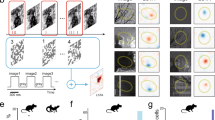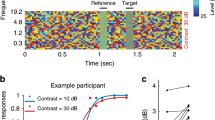Abstract
The eye functions effectively over an enormous range of ambient illumination, because retinal sensitivity can be adapted to prevailing light levels1,2. Higher order neurones in the visual pathway are presumably more concerned with relative changes in illumination, that is, contrast, because a great deal of information concerning absolute light level is processed at the retinal level3. It would therefore be of considerable functional value if cells in the visual cortex could adapt their response levels to a steady-state ambient contrast, in a manner analogous to the sensitivity control mechanism of the retina. We have examined here the idea that adaptation of neurones in the visual cortex to ambient contrast is similar to adaptation in the retina to ambient illumination. The experiments were performed by measuring contrast response functions (response amplitude as a function of contrast) of striate neurones, while systematically adapting them to different contrast levels. Our results show that, for the majority of cortical neurones, response–contrast curves are laterally shifted along a log-contrast axis so that the effective domains of neurones are adjusted to match prevailing contrast levels. This contrast gain control mechanism, which was not observed for lateral geniculate (LGN) fibres, must be of prime importance to visual function.
This is a preview of subscription content, access via your institution
Access options
Subscribe to this journal
Receive 51 print issues and online access
$199.00 per year
only $3.90 per issue
Buy this article
- Purchase on Springer Link
- Instant access to full article PDF
Prices may be subject to local taxes which are calculated during checkout
Similar content being viewed by others
References
Creutzfeldt, O. D. Electroenceph. clin. Neurophysiol. Suppl. 31, 159–169 (1972).
Werblin, F. S. & Copenhagen, D. R. J. gen. Physiol. 63, 88–110 (1974).
Barlow, H. B. & Levick, W. R. J. Physiol., Lond. 202, 699–718 (1969).
Freeman, R. D., Mallach, R. & Hartley, S. J. Neurophysiol. 45, 1074–1084 (1981).
Hubel, D. H. & Wiesel, T. N. J. Physiol., Lond. 160, 106–154 (1962).
Tolhurst, D. J., Movshon, J. A. & Thompson, I. D. Expl Brain Res. 41, 414–419 (1981).
Dean, A. F. J. Physiol., Lond. 318, 413–427 (1981).
Shapley, R. M. & Victor, J. D. J. Physiol., Lond. 285, 275–298 (1978).
Author information
Authors and Affiliations
Rights and permissions
About this article
Cite this article
Ohzawa, I., Sclar, G. & Freeman, R. Contrast gain control in the cat visual cortex. Nature 298, 266–268 (1982). https://doi.org/10.1038/298266a0
Received:
Accepted:
Issue Date:
DOI: https://doi.org/10.1038/298266a0
This article is cited by
-
Electrophysiological population dynamics reveal context dependencies during decision making in human frontal cortex
Nature Communications (2023)
-
Fixation-related saccadic inhibition in free viewing in response to stimulus saliency
Scientific Reports (2022)
-
Latency shortening with enhanced sparseness and responsiveness in V1 during active visual sensing
Scientific Reports (2022)
-
Peak-at-end rule: adaptive mechanism predicts time-dependent decision weighting
Scientific Reports (2020)
-
Prospective decision making for randomly moving visual stimuli
Scientific Reports (2019)
Comments
By submitting a comment you agree to abide by our Terms and Community Guidelines. If you find something abusive or that does not comply with our terms or guidelines please flag it as inappropriate.



